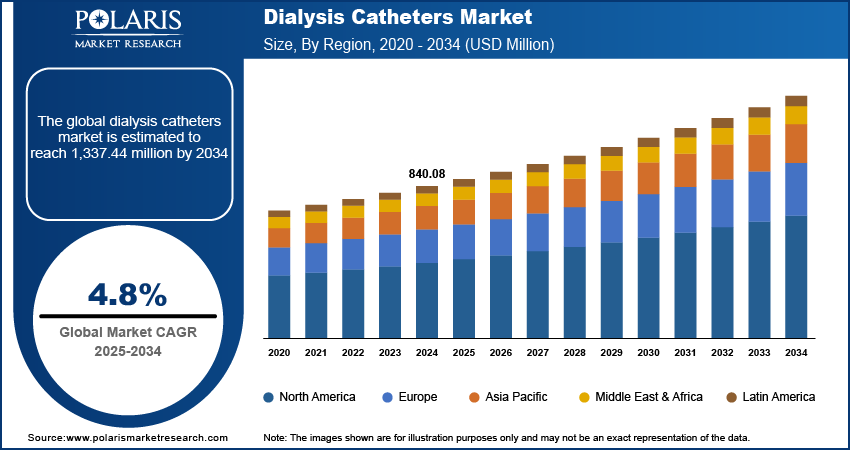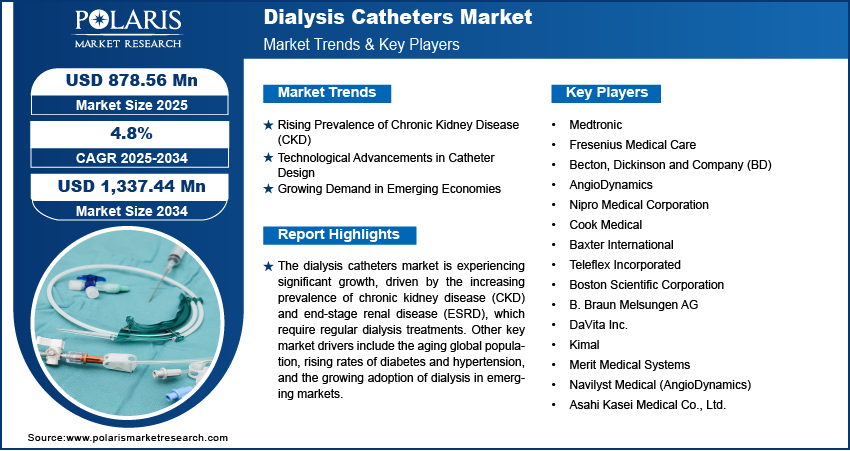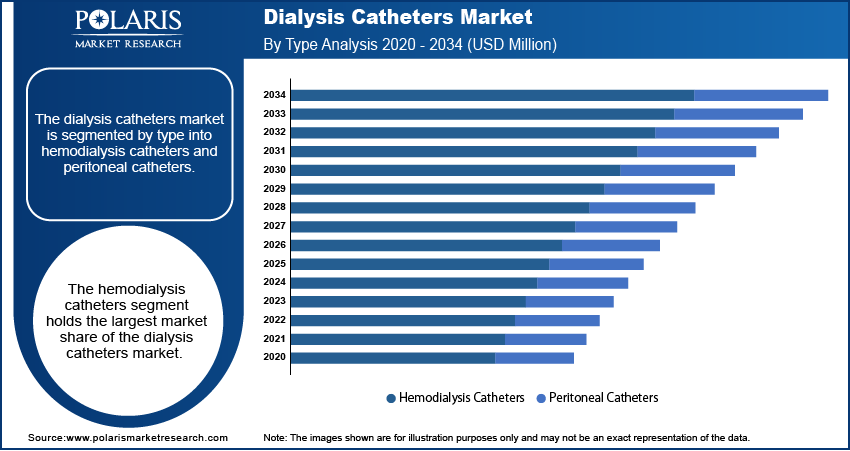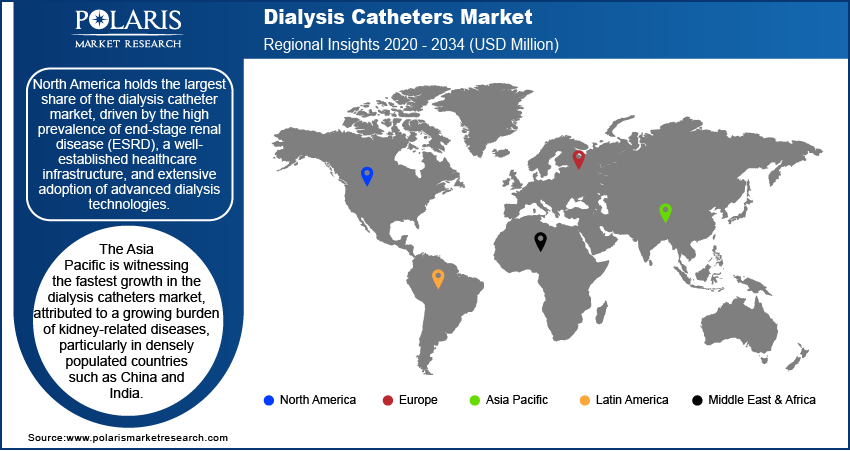
Dialysis Catheters Market Size, Share, Trends, Industry Analysis Report
: By Type (Hemodialysis Catheters and Peritoneal Catheters), By Material, By End User, and By Region – Market Forecast, 2025–2034
- Published Date:Aug-2025
- Pages: 116
- Format: PDF
- Report ID: PM1694
- Base Year: 2024
- Historical Data: 2020-2023
Market Overview
The global dialysis catheters market size was valued at USD 840.08 million in 2024 and is projected to grow at a CAGR of 4.8% from 2025 to 2034. The growth is driven by the increasing prevalence of renal disorders, the growing aging population, and the rising adoption of dialysis treatment due to the limited availability of kidney transplantation.
Key Insights
- The hemodialysis catheters segment held the largest share due to their critical role in facilitating efficient blood filtration for patients with ESRD or acute kidney injury.
- The silicone catheter sector dominates the market for long-term use due to its superior biocompatibility, flexibility, and reduced risk of reactions.
- Homecare settings are experiencing the highest growth, fueled by the increasing preference for home-based dialysis treatments, especially peritoneal dialysis.
- North America holds the largest market share due to the high prevalence of ESRD and a well-established healthcare infrastructure.
- Europe is experiencing growth driven by a high incidence of CKD and strong healthcare systems, particularly in countries such as Germany and the UK.
- Asia Pacific is the fastest growing region due to rising kidney disease rates, improving healthcare infrastructure, and government support for dialysis services.
Industry Dynamics
- The global rise in chronic kidney disease (CKD) increases the need for dialysis catheters.
- New catheter technologies, such as antimicrobial coatings, are improving treatment outcomes and lowering infection risks.
- Better healthcare access and government support in countries including India and Brazil are boosting dialysis adoption.
- The high cost of advanced dialysis catheters may make them less accessible in lower-income regions.
Market Statistics
2024 Market Size: USD 840.08 million
2034 Projected Market Size: USD 1,337.44 million
CAGR (2025–2034): 4.8%
North America: Largest market in 2024

The dialysis catheters focuses on devices used to provide vascular access for hemodialysis in patients with chronic kidney disease or acute kidney injury. Technological advancements, such as the development of antimicrobial-coated catheters and devices with improved biocompatibility, are key trends shaping the industry. Additionally, the expansion of healthcare infrastructure in emerging economies and increased awareness of dialysis treatments are contributing to the overall growth.
Market Dynamics
Rising Prevalence of Chronic Kidney Disease (CKD)
The increasing global burden of chronic kidney disease (CKD) is a significant factor driving the demand. According to the Global Burden of Disease Study 2019, approximately 700 million people globally are affected by CKD, with millions progressing to end-stage renal disease (ESRD) each year, which requires dialysis. The rising prevalence is linked to risk factors such as diabetes and hypertension, which are key contributors to CKD. This highlights the growing need for effective dialysis solutions, including high-quality vascular grafts devices.
Technological Advancements in Catheter Design
Newer catheters are designed to reduce infection rates, improve blood flow efficiency, and enhance patient comfort. For instance, antimicrobial-coated catheters are increasingly being adopted to minimize catheter-related bloodstream infections (CRBSIs), a common complication in hemodialysis. A 2023 study published in The Journal of Vascular Access found that such coatings reduced infection risks by up to 40%. These advancements are improving treatment outcomes and encouraging healthcare providers to invest in advanced catheter technologies. Thus, innovations in dialysis catheter technology are boosting the revenue.
Growing Demand in Emerging Economies
Emerging economies, particularly in Asia Pacific and Latin America, are witnessing increased adoption of dialysis due to improving healthcare access and rising awareness of kidney disease management. Governments in countries such as India and Brazil are investing in healthcare infrastructure and subsidizing dialysis treatments, driving demand for dialysis catheters. For example, India’s Pradhan Mantri National Dialysis Program has significantly expanded dialysis services across rural and urban areas. This growth is further supported by the expanding network of dialysis centers and rising healthcare expenditures in these regions.

Segment Insights:
Market Evaluation Based on Type
Based on type, it is segmented into hemodialysis catheters and peritoneal catheters. The hemodialysis catheters segment held the largest share. It is widely used due to their critical role in facilitating efficient blood filtration for patients with end-stage renal disease (ESRD) or acute kidney injury. Their demand is driven by the high prevalence of hospital-based hemodialysis treatments and the increasing adoption of tunneled cuffed catheters, which provide longer-term vascular access with reduced risk of infection compared to non-cuffed alternatives. Technological advancements, such as antimicrobial coatings and biocompatible materials, further enhance the preference among healthcare providers.
Peritoneal catheters, while less dominant, are registering significant growth, particularly in home-based dialysis programs. These catheters are integral to peritoneal dialysis, a treatment modality gaining popularity due to its convenience and cost-effectiveness for patients requiring frequent dialysis. Growth in this segment is supported by increased awareness of home-based care and government initiatives to reduce the burden on hospital infrastructure. Additionally, innovations aimed at improving catheter durability and reducing peritoneal infections are boosting their adoption, particularly in emerging economies where cost considerations are pivotal.
Market Assessment Based on Material
Based on material, it is segmented into silicone and polyurethane. The silicone catheters segment holds the largest share. Silicone is widely preferred due to its superior biocompatibility and flexibility, which minimize patient discomfort during prolonged use. These attributes make silicone catheters suitable for long-term hemodialysis, a key factor in the growing adoption of tunneled dialysis catheters. Additionally, silicone's inert nature reduces the risk of adverse reactions, enhancing patient safety. Healthcare providers often select silicone catheters for patients requiring extended vascular access, further driving their dominance.
Polyurethane catheters are experiencing the highest growth rate, primarily due to their mechanical strength and ability to facilitate higher flow rates. These characteristics make polyurethane catheters ideal for acute dialysis and short-term treatments. Rising adoption of these catheters in the emerging countries, driven by cost-effectiveness and ease of insertion, is further contributing to their growth.
Market Outlook Based on End User
Based end user, it is segmented into hospitals, ambulatory surgical centers, homecare settings, and others, with hospitals holding the largest share. Hospitals remain the primary choice for dialysis treatments due to their advanced infrastructure and availability of specialized healthcare professionals. Patients with severe renal conditions or comorbidities often require hospital-based care, where complex hemodialysis procedures are performed using high-quality catheters. The segment’s growth is further supported by the increasing prevalence of end-stage renal disease (ESRD), which drives the need for frequent hospital visits for vascular access management.
Homecare settings are witnessing the highest growth rate, driven by the rising preference for home-based dialysis modalities, particularly peritoneal dialysis. This shift is supported by advancements in portable dialysis equipment and growing awareness about the benefits of homecare, including convenience and reduced treatment costs. Government initiatives promoting home dialysis programs, especially in developed countries, also contribute to the expansion of this segment. Innovations in catheter designs that enhance patient comfort and safety during self-administered dialysis are further accelerating adoption in homecare settings.

Regional Analysis
By region, the study provides insights into North America, Europe, Asia Pacific, Latin America, and the Middle East & Africa. North America dialysis catheters market holds the largest share, driven by the high prevalence of end-stage renal disease (ESRD), a well-established healthcare infrastructure, and extensive adoption of advanced dialysis technologies. The region benefits from strong government support for kidney disease management programs, such as the Medicare End-Stage Renal Disease Program in the United States, which provides substantial funding for dialysis treatments. Additionally, the presence of leading players and a higher awareness of renal health further boosts overall growth in North America. Other regions, such as Europe and Asia Pacific, are also witnessing growth, supported by improving healthcare infrastructure and increasing prevalence of chronic kidney diseases. North America remains the dominant region due to its advanced resources and robust healthcare policies.
Europe represents a significant growth driven by the increasing prevalence of chronic kidney disease (CKD) and a strong focus on healthcare accessibility. Countries such as Germany, France, and the United Kingdom lead the region due to their advanced medical infrastructure and widespread availability of dialysis centers. Government initiatives promoting early diagnosis and management of renal diseases, coupled with an aging population, further support overall growth. Additionally, the adoption of innovative catheter technologies and the presence of key players in the region contribute to its development.
The Asia Pacific dialysis catheters market is expected to witnessing fastest growth over the forecast period, attributed to a growing burden of kidney-related diseases, particularly in densely populated countries such as China and India. Improving healthcare infrastructure, rising awareness of dialysis treatments, and government support for expanding dialysis services are also driving growth in Asia Pacific. For instance, public health programs in India aim to provide affordable dialysis access in rural and urban areas. Furthermore, the increasing adoption of home-based dialysis and cost-effective treatment options is accelerating expansion in the region.

Key Players and Competitive Insights
The market is populated by several active players offering a diverse range of products. Key companies include Medtronic, Fresenius Medical Care, Becton, Dickinson and Company (BD), AngioDynamics, Nipro Medical Corporation, Cook Medical, Baxter International, Teleflex Incorporated, Boston Scientific Corporation, B. Braun Melsungen AG, DaVita Inc., Kimal, Merit Medical Systems, Navilyst Medical (AngioDynamics), and Asahi Kasei Medical Co., Ltd. These companies are actively innovating and expanding their product portfolios to meet the growing demand for advanced dialysis solutions.
Competitive analysis reveals that companies are focusing on technological advancements to enhance catheter performance and reduce complications such as infections or thrombosis. For instance, antimicrobial coatings and advanced biocompatible materials are gaining traction in product development. Some companies are also expanding their geographic reach through partnerships and collaborations, particularly in emerging countries with increasing demand for dialysis. A strong emphasis on research and development is observed as companies strive to introduce catheters with improved durability, comfort, and functionality.
Insights indicate that large players like Medtronic, Fresenius Medical Care, and Baxter International benefit from integrated supply chains and strong brand presence, allowing them to cater to diverse needs. Mid-sized and smaller companies, such as AngioDynamics and Merit Medical Systems, are leveraging niche expertise and innovation to capture specific segments. It is highly competitive, with players continuously adapting to regulatory changes, regional demands, and technological advancements to maintain their positions.
Medtronic is a key player in the dialysis catheter market, offering a range of vascular access solutions designed for effective hemodialysis and peritoneal dialysis. The company focuses on innovation in catheter design to enhance patient safety and treatment efficiency.
Fresenius Medical Care is another prominent participant known for its comprehensive dialysis products and services. The company operates a network of dialysis centers globally and supplies high-quality catheters for chronic and acute care.
List of Key Companies in Dialysis Catheters Industry
- Medtronic
- Fresenius Medical Care
- Becton, Dickinson and Company (BD)
- AngioDynamics
- Nipro Medical Corporation
- Cook Medical
- Baxter International
- Teleflex Incorporated
- Boston Scientific Corporation
- B. Braun Melsungen AG
- DaVita Inc.
- Kimal
- Merit Medical Systems
- Navilyst Medical (AngioDynamics)
- Asahi Kasei Medical Co., Ltd.
Dialysis Catheters Industry Developments
- In October 2024, Fresenius Medical Care revealed plans to invest in a sustainable manufacturing facility in Europe, focusing on environmentally friendly practices for the production of dialysis equipment. This move reflects its broader strategy of aligning operational goals with sustainability initiatives while meeting the growing demand for renal care solutions.
- In September 2024, Medtronic announced its collaboration with a leading research institute to develop next-generation vascular access technologies aimed at reducing complications associated with long-term dialysis. This initiative underscores its commitment to addressing evolving clinical challenges in renal care.
- In August 2024, Diality, maker of the Moda-flx Hemodialysis System, collaborated with Kidney Care Partners, a coalition of kidney care stakeholders. The collaboration aims to advance patient-centered care and policy initiatives, aligning with Diality’s focus on improving kidney disease treatment.
Dialysis Catheters Industry Segmentation
By Type Outlook (Revenue, USD Billion, 2020–2034)
- Hemodialysis Catheters
- Peritoneal Catheters
By Material Outlook (Revenue, USD Billion, 2020–2034)
- Silicon
- Polyurethane
By End User Outlook (Revenue, USD Billion, 2020–2034)
- Hospitals
- Ambulatory Surgical Centers
- Homecare Settings
- Others
By Regional Outlook (Revenue, USD Billion, 2020–2034)
- North America
- US
- Canada
- Europe
- Germany
- France
- UK
- Italy
- Spain
- Netherlands
- Russia
- Rest of Europe
- Asia Pacific
- China
- Japan
- India
- Malaysia
- South Korea
- Indonesia
- Australia
- Rest of Asia Pacific
- Middle East & Africa
- Saudi Arabia
- UAE
- Israel
- South Africa
- Rest of Middle East & Africa
- Latin America
- Mexico
- Brazil
- Argentina
- Rest of Latin America
Dialysis Catheters Market Report Scope
|
Report Attributes |
Details |
|
Market Size Value in 2024 |
USD 840.08 million |
|
Market Size Value in 2025 |
USD 878.56 million |
|
Revenue Forecast by 2034 |
USD 1,337.44 million |
|
CAGR |
4.8% from 2025 to 2034 |
|
Base Year |
2024 |
|
Historical Data |
2020–2023 |
|
Forecast Period |
2025–2034 |
|
Quantitative Units |
Revenue in USD million and CAGR from 2025 to 2034 |
|
Report Coverage |
Revenue Forecast, Market Competitive Landscape, Growth Factors, and Trends |
|
Segments Covered |
|
|
Regional Scope |
|
|
Competitive landscape |
|
|
Report Format |
|
|
Customization |
Report customization as per your requirements with respect to countries, regions, and segmentation. |
How is the report valuable for an organization?
Workflow/Innovation Strategy: The dialysis catheters market has been segmented into detailed segments of type, material, and end user. Moreover, the study provides the reader with a detailed understanding of the different segments at both the global and regional levels.
FAQ's
The market was valued at USD 840.08 million in 2024 and is projected to grow to USD 1,337.44 million by 2034.
The market is projected to register a CAGR of 4.8% from 2025 to 2034.
North America had the largest market in 2024.
A few of the key players in the market are Medtronic, Fresenius Medical Care, Becton, Dickinson and Company (BD), AngioDynamics, Nipro Medical Corporation, Cook Medical, Baxter International, Teleflex Incorporated, Boston Scientific Corporation, B. Braun Melsungen AG, DaVita Inc., Kimal, Merit Medical Systems, Navilyst Medical (AngioDynamics), and Asahi Kasei Medical Co., Ltd.
The hemodialysis catheters segment accounted for the largest share of the market.
The silicone catheters segment accounted for the largest market share in 2024.
Dialysis catheters are medical devices used to provide access to a patient's bloodstream during dialysis treatment, which is essential for patients with kidney failure or severe kidney disease. These catheters are inserted into a vein or artery to allow the removal and filtration of waste, toxins, and excess fluids from the blood, a process that the kidneys can no longer perform effectively. There are two main types of dialysis catheters: hemodialysis catheters, used for hemodialysis treatments in hospitals or dialysis centers, and peritoneal dialysis catheters, used for at-home treatments where the dialysis fluid is introduced into the peritoneal cavity. Dialysis catheters are available in various materials, such as silicone and polyurethane, and are designed to minimize complications like infection or clotting.
A few key trends in the market are described below: Technological Advancements: Development of antimicrobial-coated catheters and biocompatible materials to reduce infection risks and improve patient safety. Rising Demand for Home Dialysis: Increased adoption of home dialysis options, especially peritoneal dialysis, due to patient convenience and cost-efficiency. Focus on Minimizing Complications: Innovations to reduce catheter-related infections, thrombosis, and other complications associated with long-term dialysis. Expansion in Emerging Markets: Growing healthcare infrastructure and awareness in regions like Asia Pacific and Latin America driving demand for dialysis treatments.
A new company entering the dialysis catheters market could focus on developing innovative products with advanced features such as antimicrobial coatings and enhanced biocompatibility to reduce infection risks and improve patient safety. Additionally, targeting the growing demand for home dialysis by offering easy-to-use, cost-effective solutions could provide a competitive edge, especially in emerging markets. Focusing on sustainability by utilizing eco-friendly materials and adopting environmentally responsible production processes could appeal to both consumers and regulators. Moreover, establishing strong partnerships with healthcare providers and dialysis centers for better market penetration would be key to building brand recognition and trust.
Companies manufacturing, distributing, or purchasing dialysis catheters and related products, and other consulting firms must buy the report.
